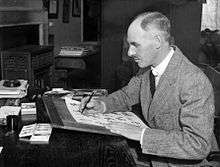H. M. Bateman

Henry Mayo Bateman (15 February 1887 – 11 February 1970, Gozo)[1] was a British humorous artist and cartoonist.
H. M. Bateman was noted for his "The Man Who..." series of cartoons, featuring comically exaggerated reactions to minor and usually upper-class social gaffes, such as "The Man Who Lit His Cigar Before the Royal Toast", "The Man Who Threw a Snowball at St. Moritz" and "The Boy Who Breathed on the Glass at the British Museum." which appeared in the satirical magazine Punch.
Early life

He was born in the small village of Sutton Forest in New South Wales, Australia. His parents were Henry Charles Bateman and Rose Mayo. His father had left England for Australia in 1878 at the age of 21 to seek his fortune, then returned to England briefly in 1885 before going back with an English wife. Soon after Henry was born, his strong-willed mother insisted that they return to London 'and civilisation'. He had one sister, Phyllis, three years younger.
Bateman was always drawing from an early age, consistently producing funny drawings that told stories. He was inspired by comics, and he had a keen critical eye, and was enthusiastically drawing at every available moment. At the age of fourteen he had already decided that he would draw for publication. In 1901, the cartoonist Phil May, in response to a letter from Rose, showed interest in his drawings, and that year he was inspired by an exhibition of black-and-white art at the Victoria and Albert Museum. His father had initially decided that his son should follow him into business, but eventually, after many arguments between him and Rose, his father financed his study at the Westminster School of Art which he commenced at the age of sixteen. He did well, but was bored by the lifeless "life" classes and after qualifying at Westminster transferred his study to the New Cross Art School[lower-alpha 1]. He also did some practical work at the studio Charles van Havenmaet.
Career
Bateman's first solo exhibition in 1901 was at the Brook Street Gallery, Mayfair. His first contract was in 1904, for ten drawings and two illustrations in a fourpenny monthly magazine called The Royal. At the age of 17, his style was already that of a mature artist. He then progressed to a contract with The Tatler and many other magazines besides, including the Illustrated Sporting News and Dramatic News, Pearson's Weekly and Punch. Bateman greatly influenced the style of American cartoonist Harvey Kurtzman.
Personal life
He married Brenda Collison Wier and they had two children, Diana and Monica, both of whom became artists. They lived at Curridge, just north of Newbury, Berkshire.
Later life, death, and legacy
In later life, he carried on an increasingly acrimonious battle with the Inland Revenue. His final years were spent on the island of Gozo.[2] A centenary celebration of his work was exhibited at Festival Hall on London's south bank in 1987. An English Heritage blue plaque, unveiled in 1997, commemorates Bateman at 40 Nightingale Lane in Clapham.[3]
Notes
- ↑ now called the Goldsmith Institute
References
- ↑ "Henry Mayo Bateman". lambiek.net.
- ↑ The Best of H. M. Bateman (Bodley Head, 1987)
- ↑ "BATEMAN, H.M. (1887–1970)". English Heritage. Retrieved 2012-10-20.
Publications
- Bateman, H. M., intr. A. E. Johnson. Burlesques. London: Duckworth, 1916. OCLC 3694458
- Bateman, H. M. A Book of Drawings. London: Methuen, 1921. OCLC 19873491
- Bateman, H. M. Colonels. London: Methuen, 1925. OCLC 29766969
Further reading
- Anderson, Anthony, The Man who was H. M. Bateman, Webb & Bower (Exeter, England, 1982) ISBN 0-906671-57-4
- Bradshaw, Percy V., H.M. Bateman and His Work, (London: Issued by the Press Art School, 1919) OCLC 77633932
External links
| Wikimedia Commons has media related to Henry Mayo Bateman. |
- H. M. Bateman: the website
- Works by H. M. Bateman at Project Gutenberg
- Works by or about H. M. Bateman at Internet Archive
- Bateman's Punch Illustrations in HeidICON
- Searchabe Archive